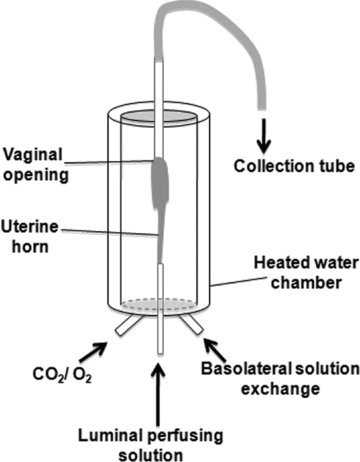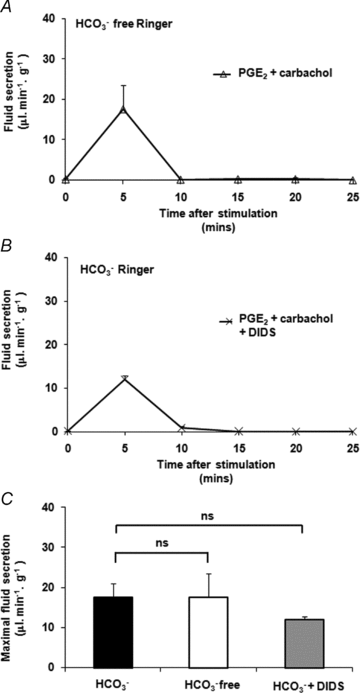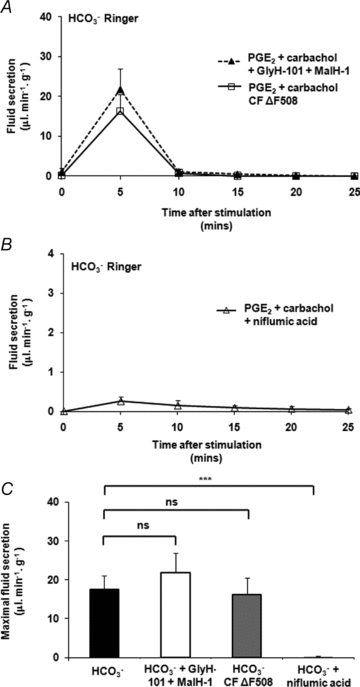A new role for bicarbonate secretion in cervico-uterine mucus release
- PMID: 20478977
- PMCID: PMC2915510
- DOI: 10.1113/jphysiol.2010.187237
A new role for bicarbonate secretion in cervico-uterine mucus release
Abstract
Cervical mucus thinning and release during the female reproductive cycle is thought to rely mainly on fluid secretion. However, we now find that mucus released from the murine reproductive tract critically depends upon concurrent bicarbonate (HCO(3)(-)) secretion. Prostaglandin E(2) (PGE(2))- and carbachol-stimulated mucus release was severely inhibited in the absence of serosal HCO(3)(-), HCO(3)(-) transport, or functional cystic fibrosis transmembrane conductance regulator (CFTR). In contrast to mucus release, PGE(2)- and carbachol-stimulated fluid secretion was not dependent on bicarbonate or on CFTR, but was completely blocked by niflumic acid. We found stimulated mucus release was severely impaired in the cystic fibrosis F508 reproductive tract, even though stimulated fluid secretion was preserved. Thus, CFTR mutations and/or poor bicarbonate secretion may be associated with reduced female fertility associated with abnormal mucus and specifically, may account for the increased viscosity and lack of cyclical changes in cervical mucus long noted in women with cystic fibrosis.
Figures








Comment in
-
Sparkling water--bicarbonate for cervix and cystic fibrosis.J Physiol. 2010 Aug 1;588(Pt 15):2685. doi: 10.1113/jphysiol.2010.194019. J Physiol. 2010. PMID: 20675814 Free PMC article. No abstract available.
Similar articles
-
Sparkling water--bicarbonate for cervix and cystic fibrosis.J Physiol. 2010 Aug 1;588(Pt 15):2685. doi: 10.1113/jphysiol.2010.194019. J Physiol. 2010. PMID: 20675814 Free PMC article. No abstract available.
-
Normal mouse intestinal mucus release requires cystic fibrosis transmembrane regulator-dependent bicarbonate secretion.J Clin Invest. 2009 Sep;119(9):2613-22. doi: 10.1172/JCI38662. Epub 2009 Aug 24. J Clin Invest. 2009. PMID: 19726884 Free PMC article.
-
Involvement of the anion exchanger SLC26A6 in prostaglandin E2- but not forskolin-stimulated duodenal HCO3- secretion.Gastroenterology. 2006 Feb;130(2):349-58. doi: 10.1053/j.gastro.2005.10.017. Gastroenterology. 2006. PMID: 16472591
-
HCO3- transport in relation to mucus secretion from submucosal glands.JOP. 2001 Jul;2(4 Suppl):280-4. JOP. 2001. PMID: 11875272 Review.
-
Bicarbonate in cystic fibrosis.J Cyst Fibros. 2017 Nov;16(6):653-662. doi: 10.1016/j.jcf.2017.06.005. Epub 2017 Jul 18. J Cyst Fibros. 2017. PMID: 28732801 Review.
Cited by
-
Novel role for pendrin in orchestrating bicarbonate secretion in cystic fibrosis transmembrane conductance regulator (CFTR)-expressing airway serous cells.J Biol Chem. 2011 Nov 25;286(47):41069-82. doi: 10.1074/jbc.M111.266734. Epub 2011 Sep 13. J Biol Chem. 2011. PMID: 21914796 Free PMC article.
-
Secretory phospholipases A2 are secreted from ciliated cells and increase mucin and eicosanoid secretion from goblet cells.Chest. 2015 Jun;147(6):1599-1609. doi: 10.1378/chest.14-0258. Chest. 2015. PMID: 25429648 Free PMC article.
-
Concurrent absorption and secretion of airway surface liquids and bicarbonate secretion in human bronchioles.Am J Physiol Lung Cell Mol Physiol. 2019 May 1;316(5):L953-L960. doi: 10.1152/ajplung.00545.2018. Epub 2019 Mar 6. Am J Physiol Lung Cell Mol Physiol. 2019. PMID: 30838869 Free PMC article.
-
The anion exchanger slc26a3 regulates colonic mucus expansion during steady state and in response to prostaglandin E2, while Cftr regulates de novo mucus release in response to carbamylcholine.Pflugers Arch. 2024 Aug;476(8):1209-1219. doi: 10.1007/s00424-024-02975-4. Epub 2024 Jun 3. Pflugers Arch. 2024. PMID: 38829391 Free PMC article.
-
Mucociliary transport in porcine trachea: differential effects of inhibiting chloride and bicarbonate secretion.Am J Physiol Lung Cell Mol Physiol. 2013 Feb 1;304(3):L184-90. doi: 10.1152/ajplung.00143.2012. Epub 2012 Nov 30. Am J Physiol Lung Cell Mol Physiol. 2013. PMID: 23204069 Free PMC article.
References
-
- Andersch-Bjorkman Y, Thomsson KA, Holmen Larsson JM, Ekerhovd E, Hansson GC. Large scale identification of proteins, mucins, and their O-glycosylation in the endocervical mucus during the menstrual cycle. Mol Cell Proteomics. 2007;6:708–716. - PubMed
-
- Ansari AH, Gould KG, Ansari VM. Sodium bicarbonate douching for improvement of the postcoital test. Fertil Steril. 1980;33:608–612. - PubMed
-
- Argueso P, Spurr-Michaud S, Tisdale A, Gipson IK. Variation in the amount of T antigen and N-acetyllactosamine oligosaccharides in human cervical mucus secretions with the menstrual cycle. J Clin Endocrinol Metab. 2002;87:5641–5648. - PubMed
-
- Bhaskar KR, Turner BS, Grubman SA, Jefferson DM, LaMont JT. Dysregulation of proteoglycan production by intrahepatic biliary epithelial cells bearing defective (ΔF508) cystic fibrosis transmembrane conductance regulator. Hepatology. 1998;27:7–14. - PubMed
Publication types
MeSH terms
Substances
Grants and funding
LinkOut - more resources
Full Text Sources
Molecular Biology Databases

